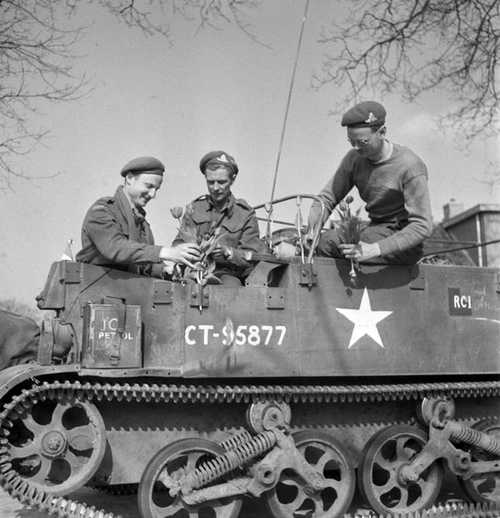
Canadian Forces
Tulips from Amsterdam - Canadian flower lovers.
Government of Canada (?)
Canadian soldiers of an antitank unit, Netherlands, 1945. Many Dutch citizens undoubtedly resented the failure of the Allies, after the failure of the Arnhem campaign, to make more limited attempts to liberate the Netherlands, leading to the horrific "Hunger Winter" in the country - particularly cold, and with very little food available. The Allies, however, had their own problems, some self-inflicted. Not least of these was the continued presence of German forces to the north of the Scheldt estuary, adjacent to the port of Antwerp. The presence of these forces made it virtually impossible for the Allies to make use of the port of Antwerp, and complicated the early stages of Operation Market Garden. Arguably, the problem of General Kurt Student and his forces in this area should have been dealt with before anything like Market Garden was attempted. The "Student problem" was dealt with, mainly by Canadian forces, in October-November, 1944. Another problem was that, in the aftermath of "Market Garden", the Allies were left with an imbalance in their deployment created by the redundant salient pointing towards Arnhem. Furthermore, as the Allies worked to sort out these difficulties, the German offensive in the Ardennes turned the attention of the Allies in Belgium and the Netherlands, necessarily, to the south, making any attempt to liberate all but the most southerly areas of the Netherlands impossible. When Winter reigns, can Spring be far behind ? Well, no. Having recovered from the shock of the "Battle of the Bulge", the Allies turned their attention to other matters - the crossing of the Rhine, of course, but also the elimination of German forces in the Netherlands. This was effected between March and early May, 1945, when German forces in the Netherlands surrendered. Much of the heavy lifting in this operation fell to Canadian forces, and it brought them through the tulip-growing area of the country at the ideal time - in mid-April, 1945. Regarding the "American" white star mark on the Universal Carrier - this was an air-to-ground recognition mark agreed between the Allies before D-Day (albeit not universally used). The Canadians, in particular, were sensitive about the apparent "Americanisation" implied by the application of this mark. Many units applied it askew to show their distinctiveness; some even applied it upside-down ! Best regards, JR.
4384 Views
2/3/2006
